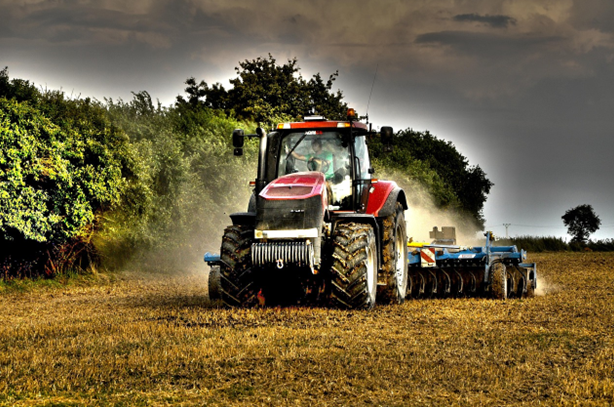How Much Does a Tractor Cost?
How Much Is My Tractor Worth?
Best Tractors for Small Farms
How Much Does a Tractor Tire Weigh?
Most Useful Tractor Implements
Most Popular Tractor Brands
What are Hay Balers?
How Many Bales of Hay Per Acre Can You Produce?
Tractors & Road Safety
What Does PTO Stand for on a Tractor? And How Does It Work?
Compact Vs. Utility Tractors: Which Is Right for Your Farm?
Best Tractor Models for Small to Medium Farms
How To Operate a Skid Steer
Skid Steer Attachments
Manure Spreaders
Grapple Buckets
How Do Combine Harvesters Work?
Autonomous Tractors
What is an Excavator?
How much does a Forklift Cost?
Different Types Of Cattle Barns
How Is Hemp Harvested?
How Does a Concrete Crusher Work? Understanding the Role and Mechanisms of Concrete Crushers
A Beginner’s Guide to Online Farm Equipment Auctions
How Online Farm Auctions Are Transforming the Ag Industry
Corn Harvesting: Where Is Corn Grown in the U.S.?
How to Write Off Farm Equipment on Taxes
Bale Beds for Sale New & Used
Guide to Tillage: What Is Tillage Equipment & Its Process?
Evolution of the Bulldozer
Bulldozers in Construction
Selling Used Farm Equipment
Understanding Commodity Price Trends
Top Tips for Successful Bidding in Online Farm Equipment Auctions
Most Efficient Corn Harvesting
Top Seeders for No-Till Farming
Square vs Round Balers
Used Tractor Buying Guide: How to Choose the Right Tractor for Your Farm
Buying a used tractor can save you thousands, but it can also lead to headaches if you're not careful. To help you make a solid choice, we've put together this straightforward guide to purchasing a used tractor. We’ll cover everything from horsepower and transmission types to important inspections and questions you should ask before buying.
Why Buy a Used Tractor?
Buying used farm equipment is a smart way to manage your budget without sacrificing quality or performance. New tractors are expensive, but a well-maintained used tractor can provide years of dependable service at a fraction of the cost.
Before jumping into the used tractor market, let’s cover the basics.
What to Consider When Choosing Your Tractor

Image by Albrecht Fietz on Pixabay
1. Tractor Size and Horsepower
Tractors are rated by horsepower (HP). Picking the right size depends on your property and tasks:
- Subcompact (20–30 HP): Great for small acreage, landscaping, and garden work.
- Compact (25–60 HP): Ideal for small to mid-sized farming tasks, mowing, and snow removal.
- Utility (40–70 HP): Good for larger farms, hauling, plowing, and more demanding jobs.
Tip: It’s always better to have slightly more power than you think you’ll need rather than too little.
2. Drive Type (2WD vs 4WD)
- Two-Wheel Drive (2WD): Less expensive, suitable for level ground and smaller operations.
- Four-Wheel Drive (4WD): Provides extra traction in wet, muddy, or rough terrain. Highly recommended for versatility and higher resale value.
Most farmers prefer the added capability of 4WD tractors, even if they cost a bit more upfront.
3. Transmission Type
- Standard (Gear-Driven): Durable, reliable, but requires frequent shifting.
- Hydrostatic: Easy operation, better maneuverability, ideal for compact tractors, but less efficient at higher horsepower.
- Hydraulic Shuttle (Power Shift): Combines the convenience of hydrostatic with gear-driven efficiency. Great for frequent loader work and shifting between forward/reverse.
4. Compatible Equipment
Make sure your chosen tractor will handle the attachments you already own or plan to buy. Pay special attention to:
- PTO horsepower (determines which implements your tractor can power)
- Hitch category compatibility (Cat I, Cat II, etc.)
5. Hours of Operation
Tractor lifespan can range from 5,000 to over 12,000 hours, depending on how well it was maintained. A tractor with low hours is typically desirable, but condition and maintenance matter more.
6. Availability of Parts
Older tractors often cost less upfront but can cause headaches when searching for replacement parts. Stick to popular models from reputable brands like John Deere, New Holland, Kubota, or Massey Ferguson to ensure easy maintenance.
Used Tractor Inspection Checklist
Inspecting your tractor thoroughly is crucial. If you’re not experienced, take along someone knowledgeable or even hire a mechanic for peace of mind. Here’s a quick checklist to get started:
Engine & Fluids
- Does it start easily and run smoothly without excessive smoke?
- Is the oil level correct and clean, or dirty and low?
- Are there leaks under the tractor (oil, coolant, hydraulic fluid)?
Transmission
- Does it shift smoothly through all gears without grinding or slipping?
- For hydrostatic transmissions, does the tractor respond smoothly without hesitation?
Hydraulics
- Check hydraulic hoses for leaks or damage.
- Do the hydraulics lift smoothly and hold positions without dropping?
Tires and Wheels
- Are tires in good condition with even tread wear?
- Look for signs of cracking or dry rot on the tires.
General Condition
- Any obvious rust or corrosion?
- Does the tractor steer straight without drifting?
- Do brakes engage firmly?
Comfort and Amenities
- Does the cab have working air conditioning, heating, or radio?
- Is the operator seat comfortable and adjustable?
If possible, test-drive the tractor cold, so you know how it starts and runs from the first use of the day.
Questions to Ask the Seller
Always ask these questions before buying:
- Why are you selling the tractor?
- How many hours are on it?
- Have there been major repairs or engine rebuilds?
- Do you have service records?
- Are you aware of any current issues or problems?
A trustworthy seller will openly share this information, helping you feel confident in your purchase.
Where to Find Used Tractors
Dealers
Dealers usually offer used tractors with thorough inspections and sometimes limited warranties. Prices can be higher, but you benefit from professional guidance and potential financing options.
Online Listings
Sites like Fastline provide nationwide listings from private sellers and dealers, letting you compare prices and models easily. Remember to thoroughly inspect before buying from private sellers.
Local Auctions
Farm auctions offer competitive prices but require quick decisions. Visit early to inspect the tractor thoroughly before bidding.
Fellow Farmers
Neighbors upgrading their equipment might offer fair deals. Again, inspect carefully, and ask why they're selling privately rather than trading in.
Making a Safe Purchase
To protect yourself when buying privately:
- Always inspect the tractor in person.
- Take along a knowledgeable friend or mechanic.
- Arrange secure payments, preferably through a bank or verified method.
- Get all paperwork, receipts, and titles clearly documented.
Final Thoughts on Buying a Used Tractor
Buying a used tractor doesn't need to be stressful. Follow this simple formula:
- Determine your horsepower and size needs.
- Choose the right transmission and drive type.
- Inspect thoroughly, test drive, and ask the right questions.
- Buy from trusted sources like dealers, reputable online marketplaces, or known local sellers.
Ready to find your next used tractor? Check out Fastline’s extensive used tractor inventory and discover reliable equipment that suits your farming needs and budget today!
